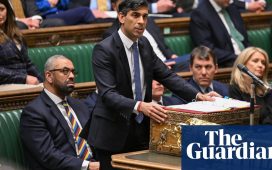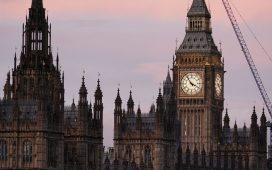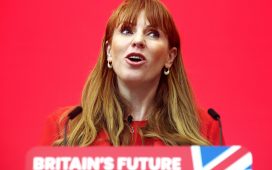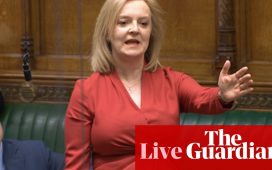AMBER Rudd resigned from her position as Work and Pensions Secretary in Boris Johnson’s Cabinet over frustrations about Brexit.
The arch-remainer accused the PM of pretending to pursue a deal with the EU. Here’s what we know about the 56-year-old MP.
Who is Amber Rudd?
Amber Rudd is a Conservative MP who served as Home Secretary from 2016 until April 2018.
She previously served as Energy and Climate Change Secretary.
Ms Rudd campaigned for Britain to stay in the EU ahead of the 2016 Brexit vote.
She is also vice-chairman of the parliamentary committee on female genital mutilation, chairperson of the all-party parliamentary group for sex equality and has campaigned to see more women in Cabinet positions.
Rudd married the late writer and critic AA Gill in 1990 and they had two children before separating in 1995.
Before entering politics she worked in investment banking in London and New York as well as setting up a recruitment business.
She worked as “aristocracy co-ordinator” on Four Weddings And A Funeral and even made a fleeting appearance in the 1994 film.
Rudd was tipped to be a future Prime Minister following her quick rise through the ranks of the Conservative party, however these hopes were dashed when she resigned on April 29, 2018, as the Home Secretary over the Windrush scandal.
Why has she resigned?
Rudd said she could no longer stand by as “good, loyal, moderate Conservatives” are kicked out of the party.
In her resignation letter, Ms Rudd — a staunch Remainer — said she joined the Cabinet in good faith accepting that No Deal had to be on the table to help clinch improved departure terms.
But she wrote: “However, I no longer believe that leaving with a deal is the Government’s main objective.”
She told the BBC there were no “formal negotiations” taking place with the EU, just “conversations”.
Ms Rudd said up to 90 per cent of government time was spent preparing for an “inferior” no-deal option.
Pals say she had become increasingly uneasy over the new PM’s hardline stance.
The final straw came when he expelled 21 senior MPs for siding with Labour to force him to abandon the threat of leaving without a deal and to delay Brexit at least until February.
Ms Rudd vowed to fight the next election as an independent Conservative but away from her Leave-voting seat of Hastings and Rye, where she has a tiny minority of just 346.
She joins a growing list of ex-Tory big guns in the Commons, including former Chancellor Philip Hammond and ex- Justice Secretary David Gauke.
A No10 spokesman said: “We are disappointed to learn Amber has chosen to leave government and the party. She was a talented welfare minister.”
Announcing her resignation, Ms Rudd accused the PM of an “assault on democracy”.
She also gave an interview to the Sunday Times in which she claimed she had seen “no evidence” the government was seriously trying to get an EU deal.
Johnson raised eyebrows when he invited the remain-backing former Home Secretary to serve in his cabinet.
Brexit Party leader Nigel Farage tweeted: “Why did Boris give ministerial posts to all these Remainers in the first place? Confused thinking to say the least.”
Former Tory leadership hopeful Rory Stewart, who had the whip withdrawn earlier this week, tweeted: “Proud of Amber Rudd – a true One Nation Conservative – we must unite to support a Brexit deal and get this done.”
Shadow Brexit secretary Sir Keir Starmer tweeted that Mr Johnson’s government was “falling apart”.
What has she said about Brexit?
Remainer Amber Rudd broke ranks with Theresa May over a second referendum – saying it was a “plausible” way through the the Brexit deadlock.
The former Work and Pensions Secretary became the first Cabinet Minister to suggest there “was an argument” for a People’s Vote.
Ms Rudd told ITV’s Peston: “I don’t want a People’s Vote, or a referendum in general, but if Parliament absolutely failed to reach a consensus I could see there would be a plausible argument for it.”
She added: “Parliament has to reach a majority on how it’s going to leave the European Union.
“If it fails to do so then I can see the argument for taking it back to the people.”
Rudd even suggested that Britain should join an EU halfway house if May’s Brexit deal fell through.
When did she become Work and Pensions Secretary?
The former Home Secretary replaced Esther McVey as Work and Pensions Secretary – putting her in charge of troubled Universal Credit.
Ms Rudd’s promotion came seven months after she was forced to quit in disgrace over the handling of the Windrush scandal.
She took the place of McVey, who stormed out of office a day earlier blasting May over the Brexit deal.
In January 2019, Rudd announced that she would oversee a new pilot scheme to pay people moving on to the scheme more frequently.
On July 24, 2019 she was also appointed as Minister for Women and Equalities in Johnson’s reshuffle.
Which constituency does Amber Rudd represent?
Rudd was re-elected in the 2017 General Election as the Tory MP for Hastings and Rye in south east England.
She was first elected as an MP there in 2010 and has lived in Hastings Old Town since 2007.
As part of her election campaign, Rudd said she would deliver a higher living wage plus proper rights and protections at work.
She said she supported investment in the NHS and wanted to provide extra funding for local schools.
Rudd also pledged to help small businesses in her constituency through business rate relief and low taxation.
Why did she resign over the Windrush scandal?
Rudd found herself under fire after it emerged Windrush immigrants were being threatened with deportation because of a 2014 bill to weed out illegal migrants.
The crackdown meant Commonwealth citizens who did not take up the offer of a British passport before 1973 were having to prove how long they had lived here.
She insisted she had only become aware of the troubles facing individual Windrush-era immigrants “over the past few months” as she revealed the Home Office was now swamped with 1,360 cases.
In a grovelling apology to MPs she said: “I bitterly, deeply regret that I didn’t see it as more than individual cases that had gone wrong, that needed addressing, that I didn’t see it as a systemic issue until very recently.”
On April 29 Rudd resigned from her position as home secretary and said in a letter to Theresa May “I take full responsibility” over the Windrush Scandal.
Who is her ex-husband AA Gill?
AA Gill was a celebrated food critic and writer who died from cancer aged 62.
He was born in Edinburgh in 1954 to English parents but moved south of the border as a one-year-old – the ‘AA’ stands for Adrian Anthony.
He began writing professionally in his thirties, joining The Sunday Times in 1993, where he stayed until his death.
The day after his death The Sunday Times published his final feature about standing up to cancer.
Rudd and AA Gill marred in 1990 and divorced in 1995 and share two children Flora and Alasdair. Following their divorce he entered into a long term relationship with model Nicola Formby who he stayed with until his death.
The food critic was a recovering alcoholic who drank “all day, every day” until the age of 30 and in 2010 he revealed his cancer stating he had been diagnosed with “an embarrassment of cancer, the full English”.
He died aged 62 on December 12, 2016.
Amber Rudd’s resignation letter in full
It is with great sadness that I am resigning as Secretary of State for Work and Pensions and Minister for Women and Equalities.
It is with great sadness that I am resigning as Secretary of State for Work and Pensions and Minister for Women and Equalities.
It has been an honour to serve in a department that supports millions of people and can be such a force for good. I would like to pay tribute to the thousands of people who work for the DWP across the country.
They are committed public servants and I am proud of the work that we have done together over the last 10 months to create a more compassionate welfare system.
I would also like to thank you and the Chancellor of the Exchequer for your support in the recent Spending Review. I am so pleased that you committed to spend millions more supporting the most vulnerable in society, and I hope that the Government will stay committed to going further at the next fiscal event, building on the work the department has done.
This has been a difficult decision. I joined your Cabinet in good faith; accepting that ‘no deal’ had to be on the table, because it was the means by which we would have the best chance of achieving a new deal to leave on October 31.
However, I no longer believe leaving with a deal is the Government’s main objective.
The Government is expending a lot of energy to prepare for ‘no deal’ but I have not seen the same level of intensity go into our talks with the European Union, who have asked us to present alternative arrangements to the Irish backstop.
The updates I have been grateful to receive from your office have not, regretfully, provided me with the reassurances I sought.
I must also address the assault on decency and democracy that took place last week when you sacked 21 talented, loyal One Nation Conservatives.
This short-sighted culling of my colleagues has stripped the party of broad-minded and dedicated Conservative MPs I cannot support this act of political vandalism.
Therefore, it is with regret that I am also surrendering the Conservative whip.
Britain’s body politic is under attack from both sides of the ideological debate. I will now play whatever role I can to help return it to a better place.
I have been lucky to have had extraordinary support from my Conservative Association since I was adopted as their candidate in 2006. Three times they helped elect me as their MP, keeping Labour at bay through nail-biting campaigns.
I remain a proud conservative and will continue to champion the values of fairness and compassion, and to support my constituents of Hastings and Rye.
Yours Sincerely,
Amber Rudd






















